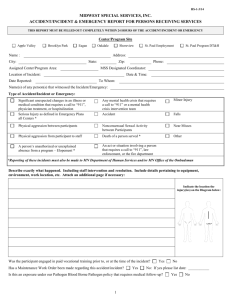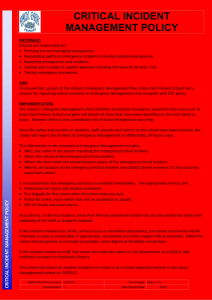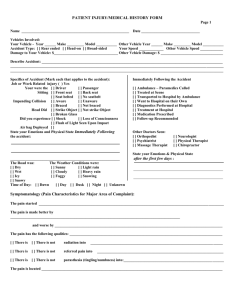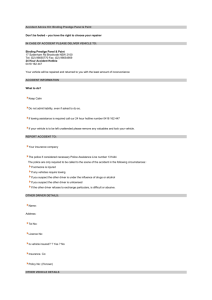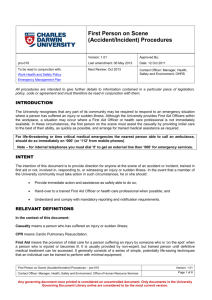Bus/Vehicle Accident Resonse Plan
advertisement
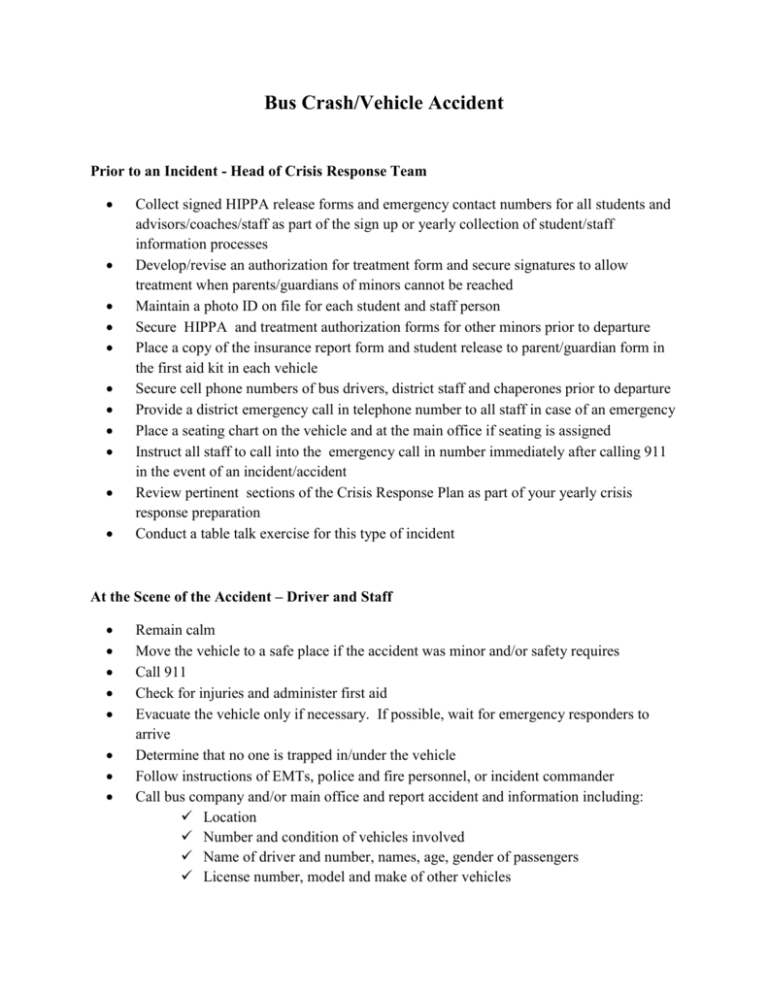
Bus Crash/Vehicle Accident Prior to an Incident - Head of Crisis Response Team Collect signed HIPPA release forms and emergency contact numbers for all students and advisors/coaches/staff as part of the sign up or yearly collection of student/staff information processes Develop/revise an authorization for treatment form and secure signatures to allow treatment when parents/guardians of minors cannot be reached Maintain a photo ID on file for each student and staff person Secure HIPPA and treatment authorization forms for other minors prior to departure Place a copy of the insurance report form and student release to parent/guardian form in the first aid kit in each vehicle Secure cell phone numbers of bus drivers, district staff and chaperones prior to departure Provide a district emergency call in telephone number to all staff in case of an emergency Place a seating chart on the vehicle and at the main office if seating is assigned Instruct all staff to call into the emergency call in number immediately after calling 911 in the event of an incident/accident Review pertinent sections of the Crisis Response Plan as part of your yearly crisis response preparation Conduct a table talk exercise for this type of incident At the Scene of the Accident – Driver and Staff Remain calm Move the vehicle to a safe place if the accident was minor and/or safety requires Call 911 Check for injuries and administer first aid Evacuate the vehicle only if necessary. If possible, wait for emergency responders to arrive Determine that no one is trapped in/under the vehicle Follow instructions of EMTs, police and fire personnel, or incident commander Call bus company and/or main office and report accident and information including: Location Number and condition of vehicles involved Name of driver and number, names, age, gender of passengers License number, model and make of other vehicles Insurance information of other driver(s) and driver’s license number(s) Insist that all passengers be checked by emergency personnel for injury and/or shock Speak only to the incident commander, other emergency responders and school administration If parents arrive at the scene before emergency responders and school administrators, ask them to wait until the emergency responders have completed their work. If they demand to take their child(ren) from the scene, have them show identification and sign a release form During a Significant Accident Involving Injury or Death – Crisis Response Team Establish contact with the police, hospitals, other emergency personnel or the on-site incident commander as soon as possible 1. Activate a secure number for communication with sheriff, police, fire and ambulance personnel 2. Request a joint communication center Call in the Crisis Response Team Assign a person to answer the emergency call in number Determine whether you will be allowed on the scene of the incident and whether or not to send an administrator to the scene Anticipate immediate and possibly extensive media coverage Attempt to determine the extent of the accident/injuries/deaths Maintain contact with adults on the scene by cell phone to ascertain additional information Activate a phone bank and call in additional staff to answer phones 1. Avoid using answering machines 2. Document all calls (use forms provided in the Crisis Response Plan) 3. Provide scripted responses 4. Refer callers to media and web site updates and provide the media update schedule Utilize pertinent sections of the Crisis Response Plan: 1. Crisis Team and Locations 2. Telephone Trees 3. Head of Crisis Response Team Duties 4. Team Duties 5. Duties of: Business Services Supervisor of Students Supervisors of Staff and Volunteers Supervisor of Public, Visitors and Parents Secretary Transportation company (if transportation is a contracted service) 6. Notification Script 7. Communication Log 8. Post Traumatic Shock Check List 9. Communication with the Media During a Crisis 10. Serious Injury/Death of Students/Staff 11. Group Discussion Following a Death or Suicide Establish contact with the parents and relatives Document information on multiple white boards or large sheets of paper for Crisis Response Team members to view and to help them understand unfolding events Regularly brief parents and relatives Establish a media briefing/staging area away from the location of the Crisis Response command center and hold regular media briefings as appropriate. Consider the following schedule: 1. Brief on the half hour to start or as appropriate 2. Change to three times per day 3. Change to once a day 4. Continue briefings until no media show up at the scheduled time Determine the location/destination of injured and uninjured survivors Determine where deceased will be taken Save all emails and other electronic communication Determine whether or not to call in counselors and, if necessary, grief support personnel Determine whether or not to separate parents and families of returning, injured, deceased victims Establish areas for: 1. Waiting parents and relatives 2. Returning victims 3. Reunification of parents, students, staff and families 4. EMT’s and other health providers to check/recheck returning victim’s for injury or signs of shock 5. Counselors and grief support personnel Establish a reunification process 1. Inform parents/guardians of documentation that will be required of them prior to taking their child(ren) 2. Release students only to properly vetted parents/guardians Meet returning buses/vehicles/victims 1. Ensure that a district person is the first person they see/talk to 2. Welcome them back 3. Express sorrow/regret 4. Share pertinent information/facts 5. Share next steps: Sign in before departing returning bus/vehicles or in a receiving room Check/recheck of each student and staff person for injury or shock (Use EMT or other health professionals) Reunification with parent/guardian/family Access to support services Information on ways to access information/updates Allow students, parents, relatives, staff, chaperones and their families to remain in the counseling and reunification areas as long as they desire to talk, process the event and receive and give support Use appropriate sections of Crisis Response Plan to begin planning for return to normalcy 1. Memorial services 2. Updates concerning funeral plans 3. Support for students and staff at funerals 4. Return to normal schedules 5. Follow up with affected students and staff After an Incident – Crisis Response Team Collect written reports from all involved staff including Crisis Response Team members Debrief Use appropriate sections of Crisis Response Plan listed above Complete required insurance and government forms and reports Meet with insurance companies and attorneys, if necessary Check in with victims and affected students and staff at regular intervals Screen Crisis Response Team members for post incident issues and post traumatic shock at regular intervals Check in with families of deceased Plan for possible media coverage of legal charges and trials Plan for anniversaries of the event including potential media coverage



